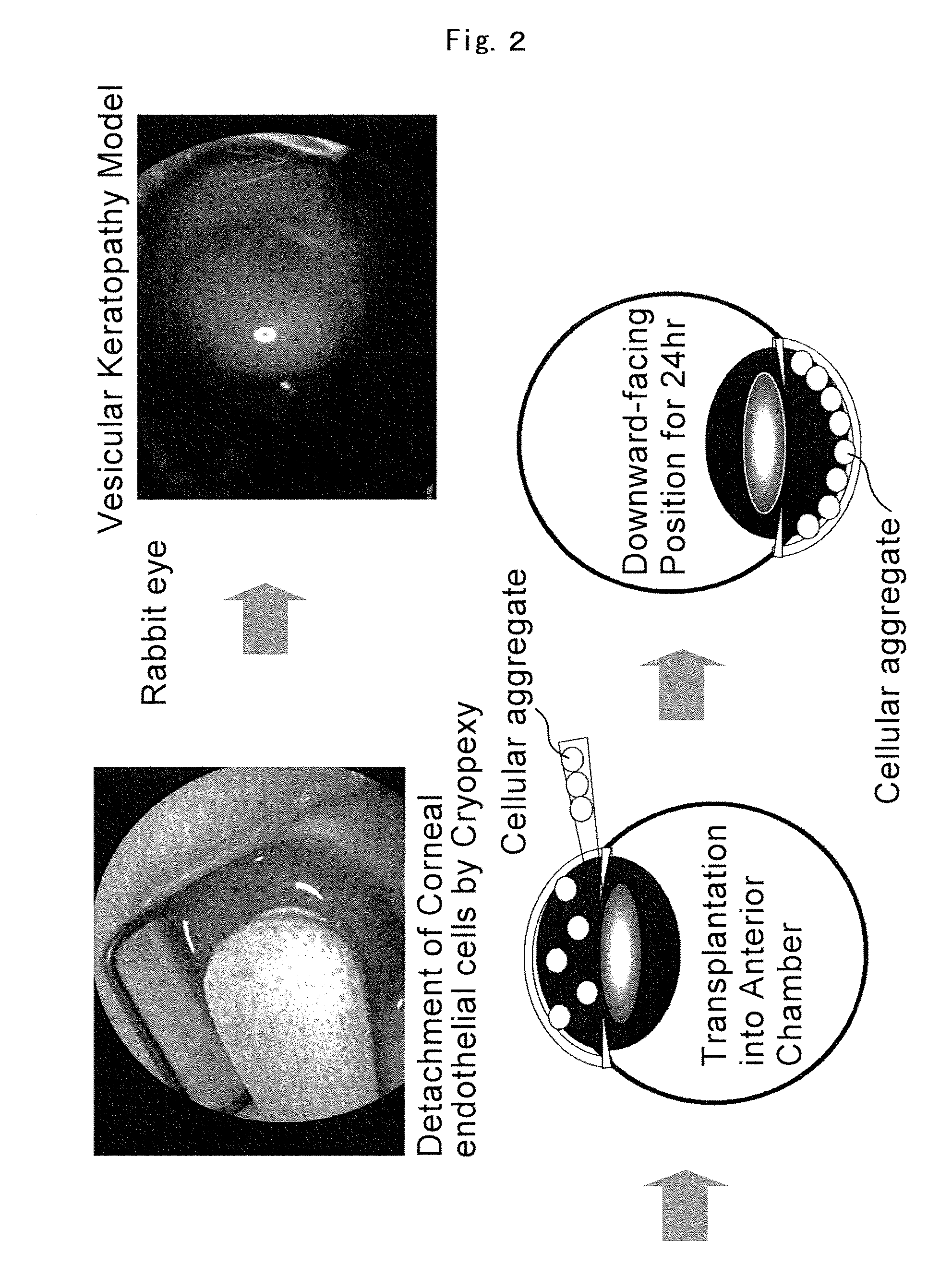Human corneal endothelial cell-derived precursor cells, cellular aggregates, methods for manufacturing the same, and methods for transplanting precursor cells and cellular aggregates
a technology of corneal endothelial cells and precursor cells, which is applied in the field of human corneal endothelial cellderived precursor cells, cellular aggregates, methods for manufacturing the same, and methods for transplanting precursor cells and cellular aggregates. it can solve the problems of corneal transplantation, tissue rejection with allotransplants, and inability to transplant, so as to enhance the ability to proliferate during culturing
- Summary
- Abstract
- Description
- Claims
- Application Information
AI Technical Summary
Benefits of technology
Problems solved by technology
Method used
Image
Examples
embodiment 1
Preparation of the Precursor Cells of Human Corneal Endothelial Cells
[0057]Corneal endothelial cells were collected from the Descemet membrane of strong sections of cornea following a full cornea transplant and primarily cultured. The cells were cultured in DMEM supplemented with 15 percent FBS at 100 percent humidity in the presence of 5 percent CO2. Cultured endothelial cells were separated from cell plates when the cell density reached saturation and subcultured for three generations, yielding precursor cells.
embodiment 2
Preparation of Cellular Aggregate from Cultured Corneal Endothelial Cells
[0058]The neurosphere method was employed as the cell culture technique. A culture solution to which 8 g / mL of methyl cellulose gel matrix had been added to prevent cellular reaggregation was employed. The base medium employed was DMEM / F12 (1:1, Sigma) to which were added 20 ng / mL of B27 (Invitrogen, San Diego, Calif.), 20 ng / mL of epidermal growth factor (EGF, Sigma), and 40 ng / mL of basic fibroblast growth factor (bFGF, Sigma). Stock cells (precursor cells) were inoculated to 50 cells / microliter (50,000 cells per well) into 24-well culture plates without coatings. Cell reaggregation did not occur under these conditions. The CO2 concentration was 5 percent.
[0059]After 7 days of culturing, the cells had grown and formed cellular aggregates. FIG. 1 shows the status of the cellular aggregates at the outset of culturing, on the first day (day 0), and on days 3, 5, and 7. The diameter of the cellular aggregates on ...
embodiment 3
Transplantation of Stem Cell-Like Cells from Cultured Corneal Endothelial Cells
[0062]The cellular aggregate obtained in Embodiment 2 was transplanted with an injector into the anterior chamber of a rabbit eye in which corneal endothelial cells had been detached by cryopexy. That is, all of the cellular aggregates in the 30 to 500 micrometer range that had been obtained by the above-described method were collected in uncoated 60 millimeter cell plates containing PBS so that the cells did not adhere. The cellular aggregates were then centrifuged and, without replacing the solution, those cells that were spherical under a stereoscope were recovered. The cellular aggregates were then washed several times with PBS by replacement of the PBS. A 300 microliter quantity of solution containing 30 to 200 cellular aggregates was introduced into the anterior chamber of each eye. A 27 or 30 G gauge was employed in this process. A downward-facing position was maintained for 24 hours following the ...
PUM
 Login to View More
Login to View More Abstract
Description
Claims
Application Information
 Login to View More
Login to View More - R&D
- Intellectual Property
- Life Sciences
- Materials
- Tech Scout
- Unparalleled Data Quality
- Higher Quality Content
- 60% Fewer Hallucinations
Browse by: Latest US Patents, China's latest patents, Technical Efficacy Thesaurus, Application Domain, Technology Topic, Popular Technical Reports.
© 2025 PatSnap. All rights reserved.Legal|Privacy policy|Modern Slavery Act Transparency Statement|Sitemap|About US| Contact US: help@patsnap.com



